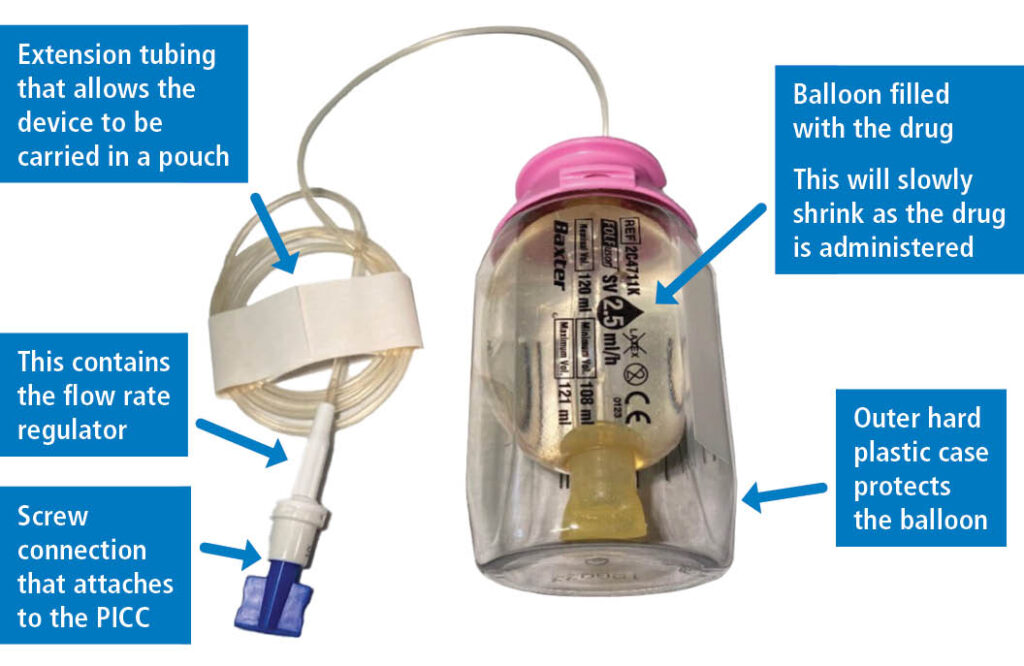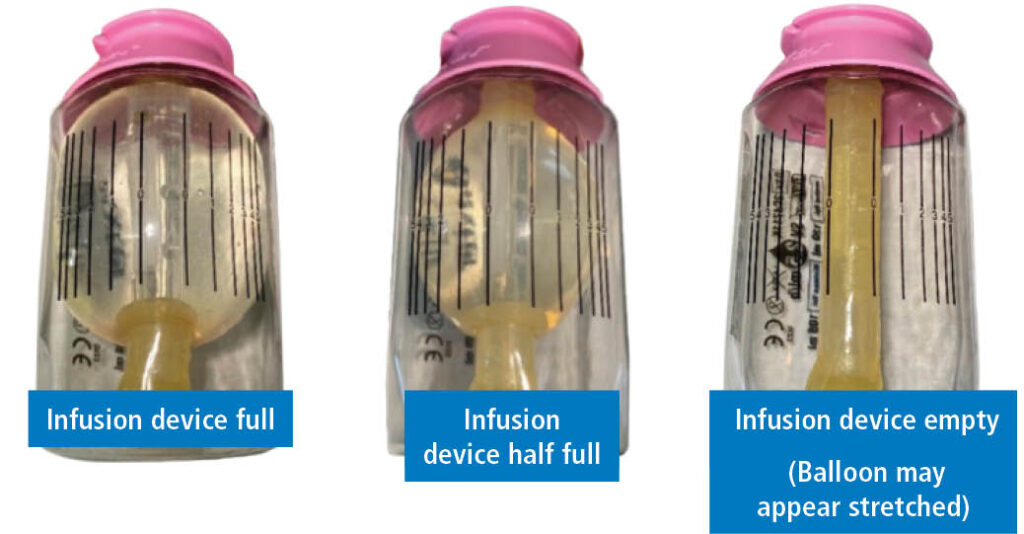This leaflet explains about the part of your treatment that you will be receiving through an infusion device while you are at home. If you have any further questions, please ask the staff on the treatment unit.
As part of your chemotherapy regimen, you will be receiving a chemotherapy drug called 5-Fluorouracil (5FU).
You will be given the 5FU treatment into one of your larger veins through a tube called a peripherally inserted central catheter (PICC) line. The PICC line will also allow for easy collection of blood samples. The chemotherapy team will discuss the insertion of the PICC line with you and provide you with further written information.
The 5FU is given directly into your vein and is delivered over a specific number of days by an infusion device. This infusion device allows for the treatment to be given at a slow and continuous rate over a set period of time. Your chemotherapy nurse will be able to tell you exactly how long your device will be attached.
The infusion device will look similar to the device in the photograph below. The infusion device will deliver your chemotherapy at a very slow drip. We have a variety of different devices of varying infusion rates and volumes to make sure we can give the treatment over the correct time period.

When connecting the infusion device to your PICC line, the nurse will show you the size of the balloon and how you can check that the contents are infusing correctly (see picture below).
Over a period of hours, you will notice that the balloon will gradually shrink in size and the markings on the outer bottle can help you judge this. The markings may be covered by labels but you should still be able to get a good indication of whether the balloon is going down or not.
You should check your device every morning and evening to see that it is shrinking. You can also weigh the pump to check the weight is decreasing.

Your nurse will attach the infusion device containing the chemotherapy to your PICC line. Once attached, it will infuse slowly over a period of days. The nurse will tape your line into a curve position against your skin. This is to make sure the flow rate regulator remains at body temperature and the PICC line is not kinked.
You will be given a pouch and a strap to hold the device. You can wear the pouch around your waist, attached to a belt, or wear the strap over your shoulder like a bag. It is normal for the device to feel strange the first time you have it attached. Once you become familiar with carrying the device around it should not interfere with your normal daily activities.
When the device is due to be disconnected, a district nurse will be asked to attend your home. This is arranged by the day unit nursing staff when you attend your first chemotherapy appointment. The device will be removed and the PICC line flushed with saline (saltwater) and secured. You will need to have the PICC line flushed and the dressing changed every seven days between your treatments, the chemotherapy team will arrange this.
The infusion device, tubing or PICC line is leaking
The infusion device does not look like it is emptying
The district nurse has not arrived to disconnect your device
If the district nurse has not arrived when expected to disconnect your device or to flush your PICC line, please contact them directly on 01274 256131- Lines open 24 hours, 7 days a week.
Eccleshill Day Unit - The Meadows
Monday – Friday
between 8.00am and 6.00pm on 01274 277483
Chemotherapy Helpline
24 hours a day, 7 days a week on 07970343305
You can contact us using the Relay UK app. Textphone users will need to dial 18001 ahead of the number to be contacted.
Bradford Teaching Hospitals NHS Foundation Trust is a smoke-free organisation. You are not permitted to smoke or in use e-cigarettes in any of the hospital buildings or grounds.